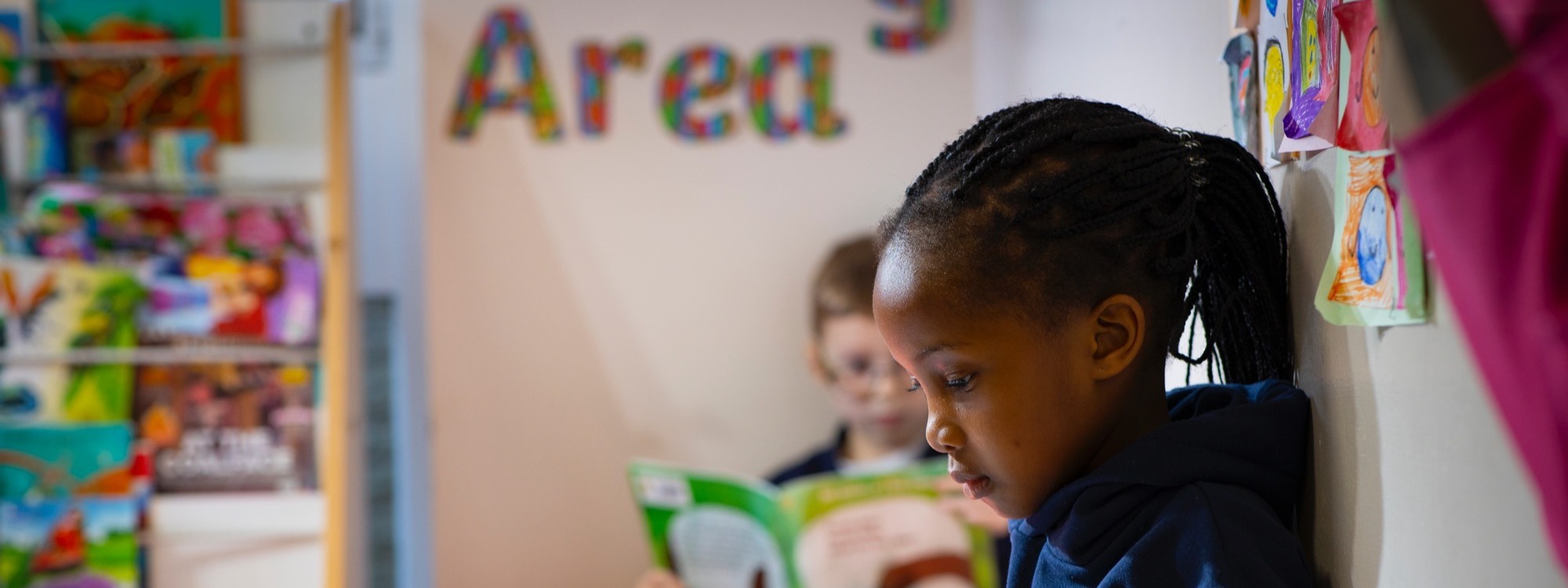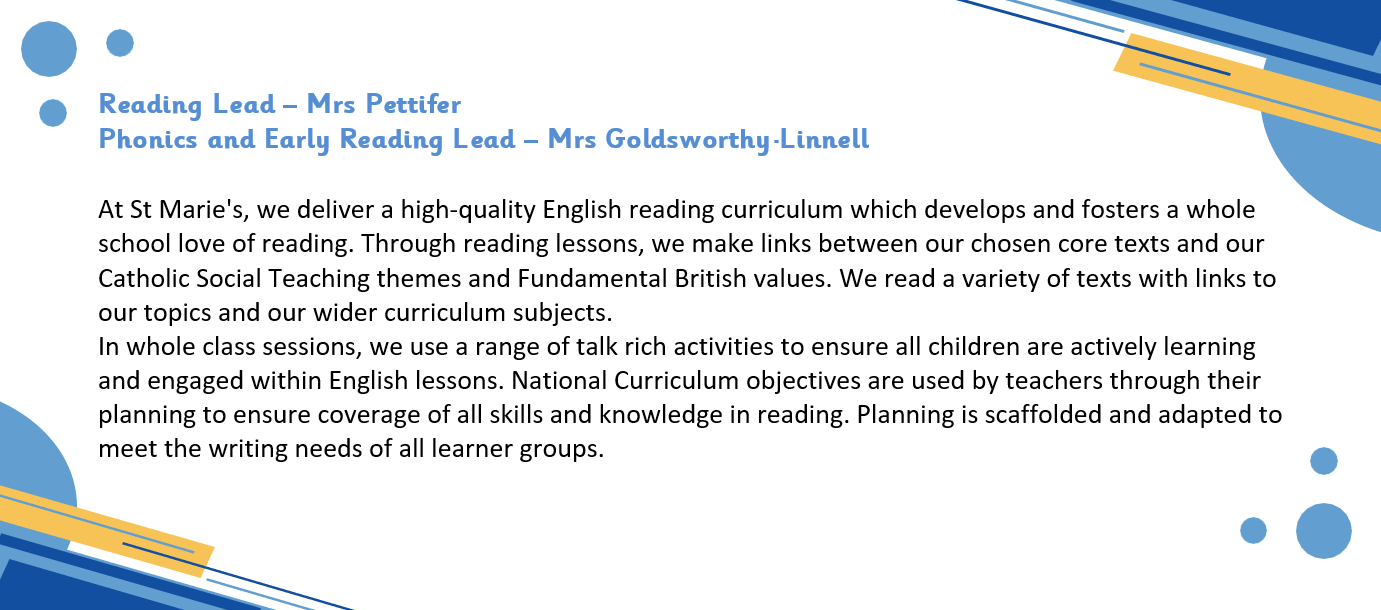
- Home
- Curriculum
- Subject Information
- Reading
Reading

Intent:
Children in EYFS, 1 and 2 are taught reading through the Little Wandle Phonics and reading fluency programme. In EYFS this happens daily. In years 1 and 2 this happens at least three times a week. It focuses on decoding, prosody and comprehension.
In KS2, reading is taught through discreet reading sessions planned by class teachers to meet the Primary National Curriculum reading scheme of work objectives and skills for their Key Stage. The mnemonic “Reading VIPERS” is used to encourage children to actively think about the comprehension skills they are using when they read. These are: V - Vocabulary I - Infer P - Predict E - Explain R - Retrieve S - Sequence (KS1) or Summarise (KS2). Throughout our EYFS and KS1 classes, children will be introduced to these terms gradually, with each explained and contextualised. Once children reach KS2, they will use these terms regularly.
To support our comprehensive English provision, Accelerated Reader was introduced in KS2 in March 2025. This is a computer-based programme to help teachers to manage and monitor independent reading practice. Through the scheme, children read books at their own reading and interest levels, ensuring that their reading is challenged and stimulated.
Our Reading curriculum is inclusive, we deliver a talk rich, targeted curriculum to all of our pupils irrespective of specific learning needs or disabilities. We adapt teaching and learning where necessary to ensure all children can access the reading curriculum through scaffolded activities, in class support, flexible environments and a variety of learning activities.
Implementation:
All year groups now plan their lessons using a 3-week writing block structure. This allows for consistency, progression and sequential writing and reading lessons across all year groups. This ensures great coverage and range of genres across year groups, opportunities for learning new skills and a chance to focus on teaching, reviewing, practising and embedding new/previous learning.
High quality texts following the Power of Reading scheme ensure that children in all year groups are given varied opportunities for reading and writing. Key skills are taught and repeated; there
are multiple opportunities to embed, apply and master key skills. Alongside these skills, we ensure extensive opportunities are available to develop and apply vocabulary, with an additional key focus on oracy development.
Planning follows the sequence below (Please see 3-week block structure attached):
KS1 follow a 3-week writing block structure:
Monday - Grammar linked to text type (wk1-3)
Tuesday - VIPERS and comprehension (wk1-3)
Wednesday - Power of Reading - identifying features (wk1)/ exploring vocabulary and oracy development (wk2)/ independent writing planning (wk3).
Thursday - Power of Reading hook and introduction to text (wk1)/ vocabulary development and shared writing (wk2)/ Independent write (wk3)
Friday - Power of Reading vocabulary and oracy development (wk1)/ Power of Reading vocabulary development and shared writing (wk2)/ Editing independent writing (wk3).
KS2 3-week writing block structure:
Monday - Identifying features related to genre (wk1)/ grammar linked to text type (wk2)/ Power of Reading- vocabulary development and share write opportunities (wk3)
Tuesday - VIPERS (wk1)/VIPERS (wk2) and independent writing plan (wk3)
Wednesday - Power of Reading Hook/intro (Wk1)/ Power of Reading vocabulary and oracy development (wk2)/ Independent writing- write/edit (cups and arms) (wk3)
Thursday - Power of Reading vocabulary and oracy development (wk1), grammar linked to text type (wk2), Independent writing- write /edit (cups and arms) (wk3)
Friday - Grammar linked to text type (wk1), Power of Reading vocabulary development and shared writing (wk2), VIPERS (wk3)
Each lesson focusses on a manageable step of new learning based on the National Curriculum Reading Scheme of work.
What a typical lesson looks like:
Flashback: an opportunity for pupils to retrieve and build upon previously acquired skills, through a ‘Last Lesson, Last Unit, Last Year, Challenge’ approach.
Teach it: Introduction to new learning with live modelling and explicit addressing of potential misconceptions.
Practise it: Children are given the opportunity to practise and use new skills. Learning can be independent and collaborative, all pupils participate through active learning strategies.
Prove it: Using the VIPERS model, children apply new knowledge and reading skills: Phonological awareness, decoding (alphabetic principle and letter-sound correspondences), sight recognition, background knowledge, vocabulary, language structures, verbal reasoning and literacy knowledge.
Dig deeper: To ensure all children are appropriately challenged, the primary national curriculum reading scheme of work is used to plan activities to enable all children to extend their learning, broaden their knowledge and make progress at their level.
Impact:
At St Marie's we believe that reading is the key to unlocking all curriculum areas of learning. We focus our time, resources and dedication into reading sessions across the school to ensure that all children are making good progress in their reading and become independent, lifelong readers. We feel passionate about our pupils developing a love of reading and so we ensure that they are exposed to and immersed in a variety of text types, genres and authors inside and outside of their classroom. Texts used in whole class teaching often focus on texts which are just slightly above the reading level of the children in the class to ensure progression is made and high aspirations set.
Assessment:
All year groups complete PIRA reading assessments 3x a year (Year 2 and 6 SATs papers). Teachers complete PIRA QLA documents to identify gaps and areas of need for individual pupils as well as the class cohort. Teachers use QLA data to inform future planning and teaching. Continued monitoring and assessment through questioning, live marking and observing in each lesson also informs planning.
Monitoring, Evaluation and Review
Teaching and learning of reading is captured through: Lesson drop ins, questioning, pupil voice, book looks, planning monitoring, NC objectives coverage monitoring, data drops (termly) and pupil progress follow up, internal and MAC moderation, Little Wandle assessment, Accelerated Reader performance, Year 2 and Year 6 SATs results, Year 1 Phonics screening scores, PIRA Assessments 3x year (Reception 2x year).
USEFUL lINKS TO SUPPORT WITH early READING:
Phonics pronunciation - Reception Autumn 1 (Phase 2)Phonics pronunciation - Reception Autumn 2 (Phase 2)Phonics pronunciation - Reception Spring 1 (Phase 3)Phonics - How we teach blendingPhonics - Alien wordsPhonics - Tricky words